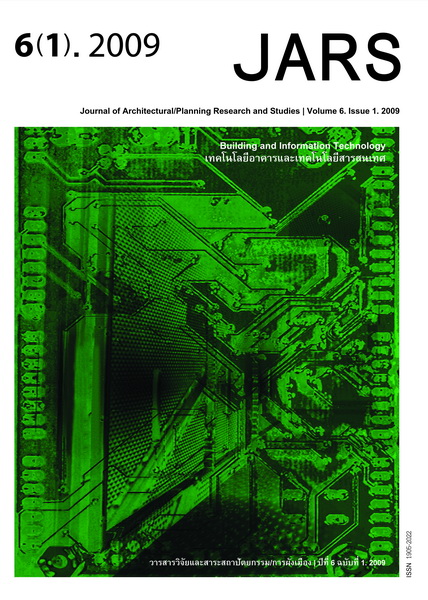Interactive 3D Simulation System in Collaborative Virtual Environment for Architectural Design Communication: Exploratory Research Approach
Main Article Content
Abstract
Nowadays technology of computer game engines have reached a level of 3d visual quality plus the
fourth dimension-a time line of realistic of virtual environment that makes them much more useful in applying on
other applications besides mere entertainment. This paper presents innovative prototype which benefits in
Interactive 3D Simulation System for architectural design communication and architecture communication with
the simulation of real world phenomenon through development and application of virtual environment simulation
base on the CryEngine2 technology. The objective of this study is to explore and analyse method of learning
and using computer game engine technology that have several unique features that able to reserve real-time
collaborative virtual environment from multi-player who related with designer team including using a media in
presenting architectural designs which is easily perceived and understood by the project owner or general
users. In addition, the CryEngine2 is easy for learning & improvement for designer who is non-programmer as
well as efficiency in presenting realistic virtual worlds featuring user friendly interaction. Finally, this paper
attempts to explore and suggest different ways to apply this tool to improve architectural design communication.
Downloads
Article Details

This work is licensed under a Creative Commons Attribution-NonCommercial-NoDerivatives 4.0 International License.
All material is licensed under the terms of the Creative Commons Attribution 4.0 International (CC-BY-NC-ND 4.0) License, unless otherwise stated. As such, authors are free to share, copy, and redistribute the material in any medium or format. The authors must give appropriate credit, provide a link to the license, and indicate if changes were made. The authors may do so in any reasonable manner, but not in any way that suggests the licensor endorses you or your use. The authors may not use the material for commercial purposes. If the authors remix, transform, or build upon the material, they may not distribute the modified material, unless permission is obtained from JARS. Final, accepted versions of the paper may be posted on third party repositories, provided appropriate acknowledgement to the original source is clearly noted.
References
Bhatrakarn, T. (2003). สถาปัตยกรรมกับการออกแบบสร้างสรรค์ อย่างดิจิทัล [Design plus digital]. Bangkok, Thailand: Kingmongkut’s Institute of Technology North Bangkok Press.
Campbell, D. A., & Wells, M. (2008). A critique of virtual reality in the architectural design process. Retrieved April 1, 2008, from http://www.hitl.washington.edu/publications/r-94-3/
Chiu, M. (1995). Collaborative design in CAAD studios: Shared ideas, resources, and representations. Proceedings of Sixth International Conference on Computer-Aided Architectural Design Futures. Singapore, 749-759.
Churchill , E. F., Snowdon, D. N., & Munro, A. J. (2001). Collaborative virtual environments. New York: Springer.
Crytek GmbH. (2008a). CryENGINE 2 Sandbox 2 manual. Retrieved April 10, 2008, from http://doc.crymod.com/SandboxManual/frames.html?frmname=topic&frmfile=index.html
Crytek GmbH. (2008b). CryENGINE 2 - Specifications. Retrieved April 1, 2008, from http://www.cryengine2.com
Ellis, C. A., Gibbs, S. J., & Rein, G. (1991). Groupware: Some issues and experiences. Communications of the ACM, 34(1), 38-58.
Fukuda, T., Sakata, K., Yeo, W., & Kaga, A. (2006). Development and evaluation of a close-range view representation method of natural elements in a real-time simulation for environmental design-shadow, grass, and water surface. Proceedings of the 24th eCAADe Conference on Communicating Space(s). Volos,
Greece, 58–65.
Guilfoyle, E. (2007). Half-life 2 mods for dummies. London: Wiley Publishing.
Herrlich, M. (2007). A tool for landscape architecture based on computer game technology. Proceedings of the 17th International Conference on Artificial Reality and Telexistence. Esbjerg, Jylland, Denmark, 264-268.
Jung, T., & Yi-Luen E. D. (2000). Immersive redliner: Collaborative design in cyberspace. Proceedings of International Conference ACADIA 2000 on Eternity, Infinity and Virtuality in Architecture. Washington, D.C., 185-194.
Kerr, S. J. (2002). Scaffolding-design issues in single & collaborative virtual environments for social skills learning. Proceedings of the 8th EUROGRAPHICS Workshop on Virtual Environments. Barcelona, Spain, 81-91.
Miliano, V. (1999). Unrealty: Application of a 3D game engine to enhance the design, visualization and presentation of commercial real estate. Proceedings of VSMM’99 5th International Conference on Virtual Systems and Multimedia. Dundee, Scotland & U.K.
Mittring, M. (2007). Finding next gen: CryEngine 2. Proceedings of International Conference on Computer Graphics and Interactive Techniques Archive. San Diego, CA, 97-121.
More, G., & Burrow, A. (2007). Observing the learning curve of videogames in architectural design. Proceedings of the 4th Australasian Conference on Interactive Entertainment. Melbourne, Australia, Article No.17.
Schmitt, G. (1999). Information architecture: Basis of CAAD and its future. Basel, Switzerland: Birkhauser.
Senyapili, B. (1997). Visualization of virtual architecture. Proceeding of 1997 IEEE Conference on Information Visualization. London, 260-266.
Shiratuddin, M., & Thabet, W. (2002). Virtual office walkthrough using a 3D game engine. International Journal of Design Computing, 4, 1329-7147.
Sifniotis, M. (2008). Featured 3D method: 3D visualisation using game platforms. 3D Visa Bulletin 3. Retrieved June 1, 2008, from http://www.3dvisa.cch.kcl.ac.uk/paper_sifniotis
Trenholme, D., & Smith, S. P. (2008). Computer game engines for developing first-person virtual environments. Journal of Virtual Reality, 12(March), 181-187.
Bowman, D. A., Kruijff, E., LaViola, J. J., & Poupyrev, I. (2005). 3D User interfaces theory and practice. Boston, MA: Pearson Education.
Doesinger, S. (2008). Space between people: How the virtual changes physical architecture. Munich, Germany: Prestel.
Hearn, D., & Baker, M. P. (2004). Computer graphics with openGL (3rd ed.). Upper Saddle River, NJ: Pearson Education.
Kalawsky, R. S. (1993). The science of virtual reality and virtual environments. New York: Addison-Wesley Longman Publishing.
Mitchell, W. J. (1977). Computer-aided architectural design. New York: Van Nostrand Reinhold.


